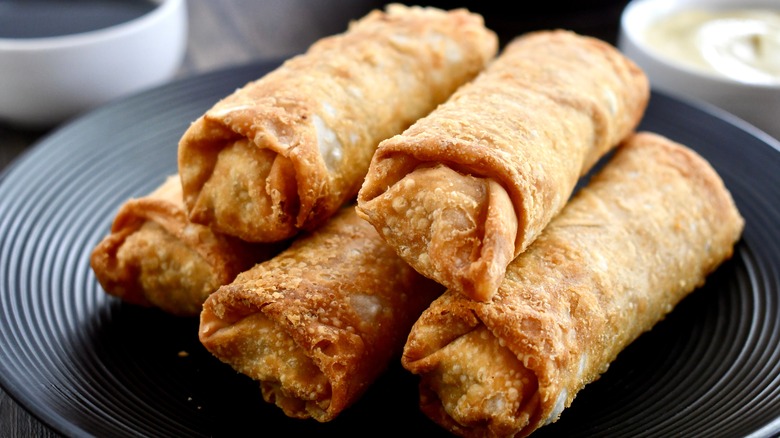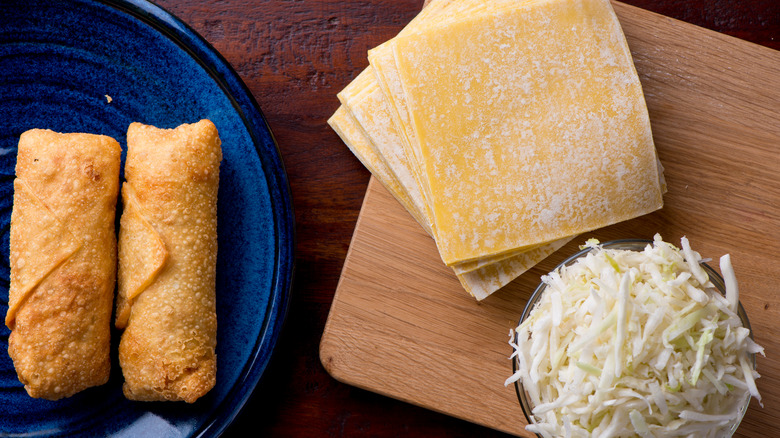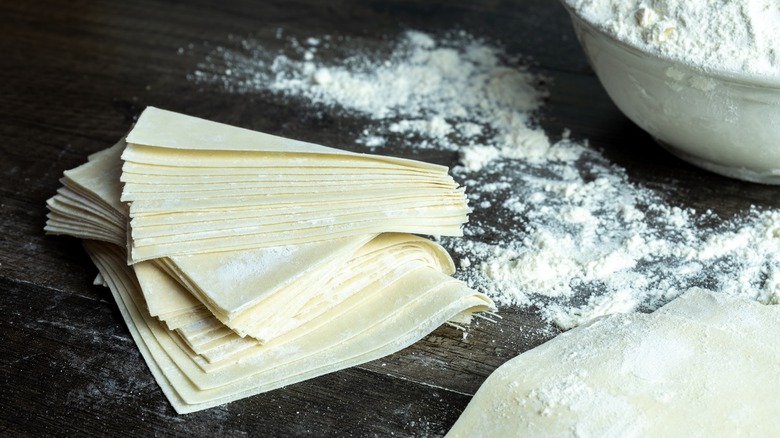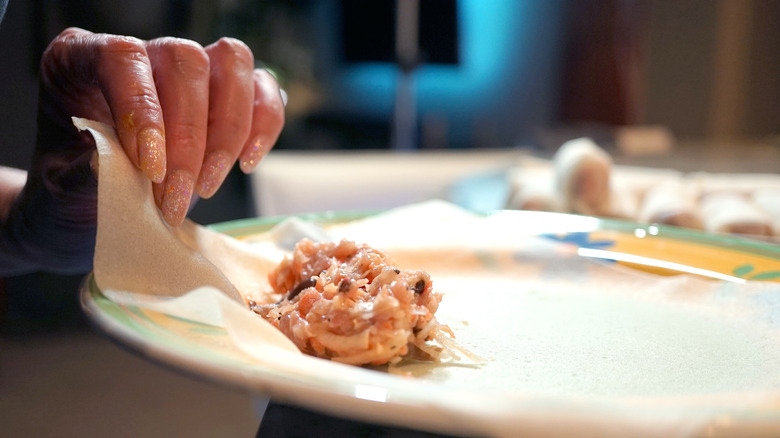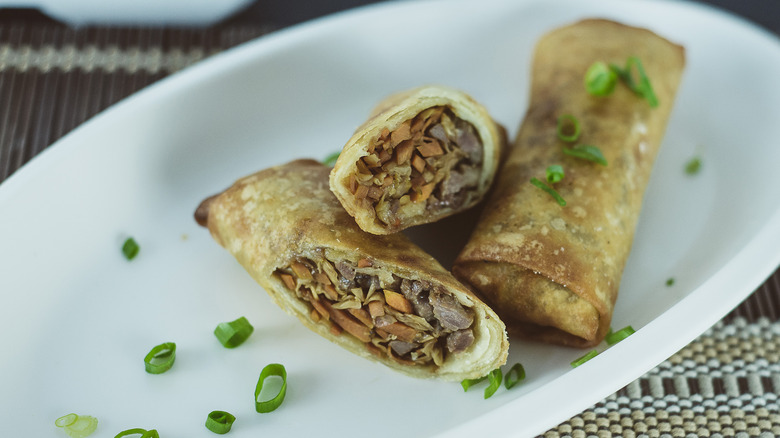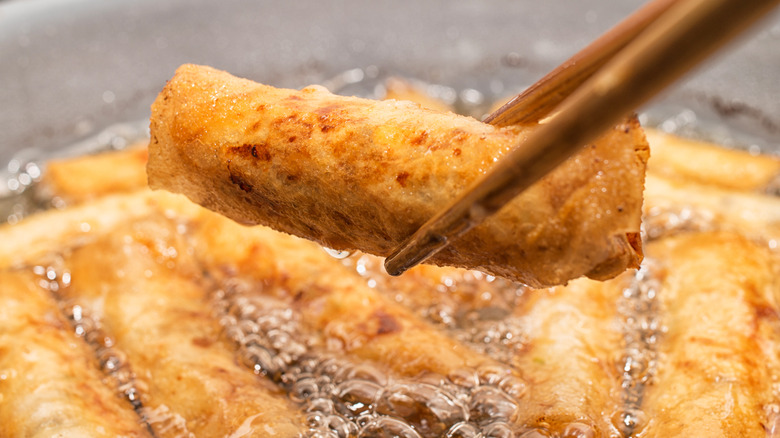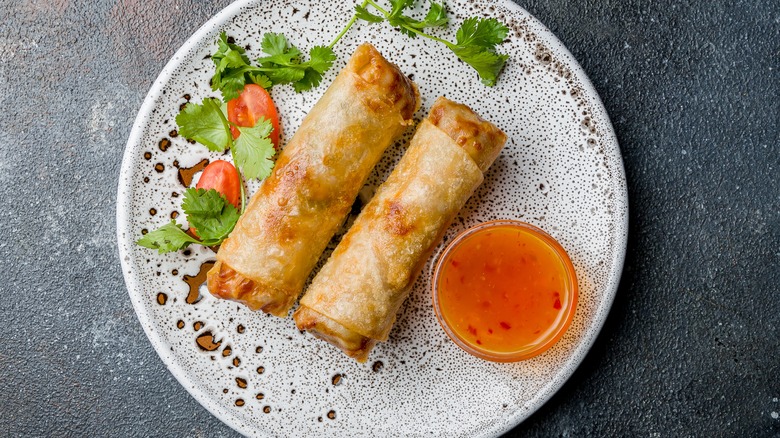How To Fold Egg Rolls Like A Total Pro
With a satisfying crunch, umami-packed filling, and sweet sauce for dipping, no Chinese take-out order is complete without a fried egg roll (or two). Whether hot or cold out of the fridge the next day, this crispy appetizer is irresistible.
Despite the name, this dish does not contain eggs, although the wrappers are thought to have once included them. Its name is believed to originate from a 1917 recipe called "Dan Gun," which translates to "egg roll." Dan gun contained meat and vegetables in a crepe-like egg wrapper. Today, egg rolls are prepared with wheat flour wrappers and often filled with shredded cabbage and ground pork, but the name has stuck.
Egg rolls are surprisingly easy to make, whether you're preparing the filling from scratch with fresh ingredients or taking some shortcuts with store-bought options. Like stir-fry or fried rice, making egg rolls is an excellent way to clear out your refrigerator. Needing just a scant ¼ cup of filling each, egg rolls can be prepared using any combination of meat, noodles, or vegetables, turning last night's leftovers into a delicious appetizer — just don't forget the dipping sauce. With a little practice, you'll be folding egg rolls like a total pro in no time.
Ingredients and tools needed to prepare egg rolls
Similar to making dumplings, it's best to have all the ingredients in front of you, like an assembly line. You'll need egg roll (not spring roll) wrappers, a small bowl of water, a damp towel, the filling, and plenty of oil for deep frying. Vegetable oil is recommended due to its high smoke point and neutral flavor.
The key to making delicious egg rolls is to purchase the proper wrappers (or skins). Egg roll wrappers are often sold by the pound, with roughly 16 skins to a pound. Packages can be found in the frozen food aisle of most grocery stores, but be prepared to shop at a local Asian market. Look for familiar brands like Twin Marquis, Spring Home, Wei Chuan, or Twin Dragon. They should be thin and roughly an eight-inch square to accommodate the filling. Allow them to thaw in the refrigerator overnight.
A small bowl of water is needed to wet your fingertips to activate the gluten in the wraps, sealing in the filling. Egg roll wrappers dry out quickly, so keep the unused stack under a damp towel to prevent them from becoming brittle. As for the filling, assume you will need ¼ cup per egg roll, so prepare four cups of filling for each pound of wrappers you purchase.
How to lay out the wrapper
As the cooking oil preheats, begin folding the egg rolls. Place an egg roll wrapper on a clean work surface with one of the corners pointing towards you, forming a diamond shape. Remember to keep the remaining wrappers under a damp cloth to prevent them from drying out.
Mound three to four tablespoons of your cooled filling on the egg roll wrapper, just shy of the center. The mixture should be tube-shaped and spread out in a line, stopping an inch from the left and right corners. Do not extend the filling all the way to the edge.
How to fold egg rolls
Moisten your fingertips with water and wet the corner pointing towards you. Fold that corner tightly over the filling, tucking it underneath. Dampen the left and then the right corner with water and repeat the process, folding the corners over the filling like a burrito. Ensure the wrappers adhere to each other. If there isn't a tight seal, dampen the wrappers again with a bit of water.
How to roll the filling
Once the sides are tucked in, wet the remaining far corner with water and tightly roll the wrapper around the filling to finish making an egg roll. Ensure the filling is completely encased in the wrapper, adding more water if necessary. Set the first egg roll aside and continue with the remaining wrappers while the oil heats up.
How to cook egg rolls
Traditionally, egg rolls are deep-fried, but alternative cooking methods include baking and air-frying.
To fry the egg rolls, heat a Dutch oven with four inches of vegetable oil to 375 degrees Fahrenheit. The egg rolls should sizzle upon entering the oil. It's crucial to maintain a consistent temperature, so use a thermometer and avoid overcrowding the pan. If the oil temperature drops significantly, the wrappers will absorb more oil and become soggy. Cook the egg rolls for five to six minutes, turning them to ensure even browning. Once golden brown, transfer the cooked egg rolls to a wire rack to drain and cool while you continue with the rest.
Egg rolls can also be air-fried using less oil. Preheat the air fryer to 350 degrees Fahrenheit. In batches, place the egg rolls in the air-fryer basket, spraying or brushing them with oil. Cook for about 10 minutes until golden brown on one side. Then flip them, lightly coat the other side with oil, and cook for another eight minutes.
To bake them, set the oven to a slightly higher temperature, 425 degrees Fahrenheit. Arrange the egg rolls on a greased sheet pan, seam-side down, and spray them with a bit of oil. Bake for 10 to 15 minutes, until golden brown.
How to freeze and reheat egg rolls
Once you defrost the egg roll wrappers, it's best to use the entire package so the skins don't dry out. However, this doesn't mean you have to consume 16 egg rolls in one sitting, as they freeze and reheat well. While egg rolls can be frozen uncooked, it's more convenient to deal with the mess once and freeze the cooked leftovers. This strategy allows you to reheat homemade egg rolls any day of the week without the lingering odor of frying.
Allow the cooked egg rolls to cool before storing them in a resealable, airtight container for up to three months. Defrosted egg rolls can be microwaved for a few minutes, but reheating them in a 425-degree Fahrenheit oven yields the best results. Brush or spray them with oil and bake for 10 minutes, turning halfway through the cooking time. They will emerge crispy and delicious.
To freeze uncooked egg rolls, arrange them in a single layer, seam side down, an inch apart on a sheet pan, and place them in the freezer. This step prevents them from sticking together. Once frozen, transfer the egg rolls to a resealable container. There's no need to thaw uncooked egg rolls before cooking. Simply drop them into 375-degree Fahrenheit vegetable oil and add a few minutes to the cooking time.

